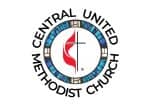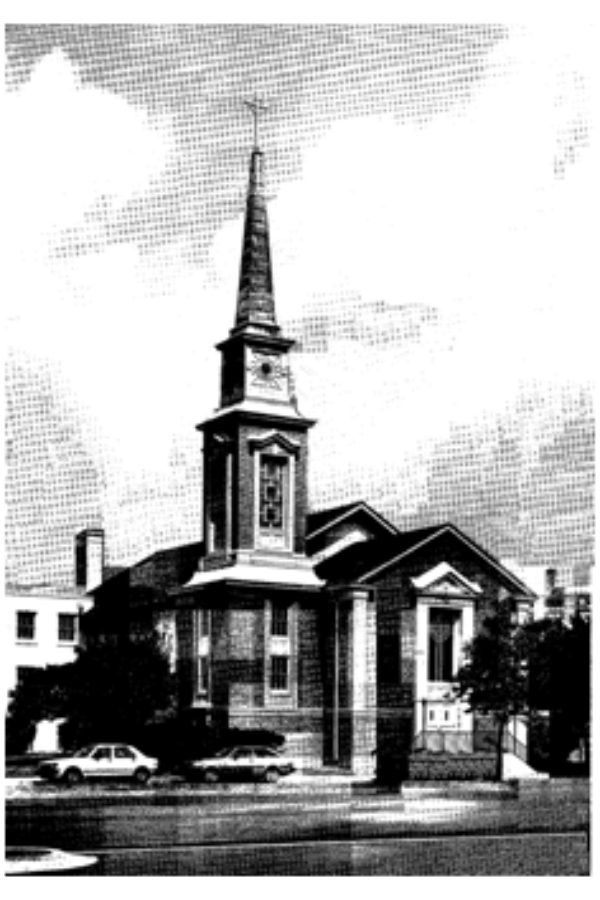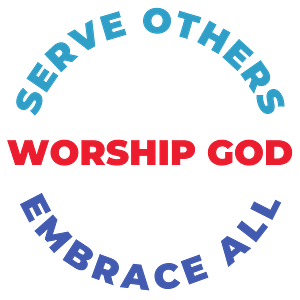

At the core of Central United Methodist Church is a feeling of community, a strong core of committed believers who express their faith through service and acceptance. Because of the transience common to the area, people remain connected through our communications and prayers. Because the area draws individuals and families from diverse nations, our connections reach not only throughout the United States but also into a number of foreign countries. This has contributed to the diversity of the congregation, and in turn, this diversity has increased the feeling of welcome and acceptance.
Central has taken on different types of outreach, responding to different needs in the community. A few examples from the last decade include collecting school supplies for Barrett and Drew Elementary School and Casa Mariflor, health kits for the United Methodist Committee on Relief, hydration kits, and toys for children at Christmas to both Casa Marilfor, Dr. Bear’s Closet at Children’s National Hospital and Toys for Tots. By far, the ongoing work with the homeless and the advocacy for affordable housing in our community has been a dedicated full time mission for Central.
How did Central United Methodist Church find its way into the ministry of supporting the homeless? How have we arrived at the opening of a high rise with 144 affordable housing units located on our land and managed by the Arlington Partnership for Affordable housing? This is an attempt to tell this story which will illustrate the development of a crucial ministry and hopefully inspire others to follow that still small voice inside urging you to respond to a need you may see in your community. This story is the result of many voices, dreams and prayers coming together with the hope of helping our neighbors and our community thrive.
It may have begun with Mary Jean Evans, a lay leader at Central. Through her work as a psychiatrist and social worker, she knew homeless individuals who had recently died from the cold. She took it upon herself to put blankets in her car and on cold nights, she would drive around and pass them out where she lived in Georgetown. She was insistent that we need to do something to support the homeless.
Another couple, Paul and Linda Keister, knew Bishop Storey from their time living in South Africa. In March 2007, Bishop Storey was in the US and met with the leadership at Central to discuss how they might use the church building to better serve the community. Bishop Storey suggested a prayer walk in the neighborhood to get a sense of the community and its needs. He also thought our courtyard was amazing and from that idea, we started outdoor concerts on Friday evenings.
Mary Jean’s insistence, Bishop Storey’s suggestion, and the experience of the prayer walk led Rev. Richard Cobb, Central’s minister at that time, and Gene Cross to realize that the work of the church had to be outside the walls of the building. The prayer walk made it clear that we had an opportunity to serve our unhoused neighbors, so we contacted Rev. Dr. Kerry Kincannon who led Rising Hope United Methodist Mission Church with a focus on serving people living in poverty and experiencing homelessness in Alexandria. We wanted to explore what the needs were and talk to him about some of the practical considerations in working with that community. Rev. Kincannon explained many of the resources that were already available and led us to Leonard Chari at A-SPAN (Arlington Street People’s Assistance Network). Leonard was the Acting Director while they looked for a replacement for the previous director. As of this writing, he is still working with this group, now renamed Pathforward.
Leonard explained the situation in Arlington, and he identified many of the resources available. At the time, there was no year-round shelter, so A-SPAN ran the hypothermia shelter at Courthouse that operated only between November through March. A-SPAN had a street outreach program that was focused on getting people on the street connected to services that could improve their situation. At that time, they operated on the second floor of AFAC’s (Arlington Food Assistance Center) building off Four Mile Run. They had a shower, laundry and counseling services. The weakness was that the homeless weren’t in that area to a great extent so the outreach ministry was really important.
Leonard said what was really needed was a place that was closer and more accessible to the homeless population. If the church could supply the location and the draw he would supply the outreach personnel to get people connected to the services that were available. This finally seemed like a win-win. The church didn’t have resources that could provide the connection, but we certainly had the resources of space and we could provide food that would draw people to the services.
The next step was to get the support of the preschool. How would the parents feel about having the homeless population in the same building as their children? How would we deal with the neighbors with those people being drawn to their doorstep. We were able to get support from Kinhaven with the understanding that the program would begin as a pilot. We would start with a 3 month program, which would extend if there were no problems. We had a nervous start, not without some initial scares. A-SPAN’s outreach folks put the word out.
Around 2008/2009, the church started offering coffee, juice, doughnuts and sack lunches to those that came. Paul Keister, Richard Cobb, Steve Barham and Gene Cross were the initial staff. Hilary Donovan and Betty Dwyer made up the lunches. (These women were making sandwiches for the homeless prior to this time. They would send the sandwiches to A-SPAN to distribute.) Leonard was there from A-SPAN to keep order and help. We purchased doughnuts from 7-Eleven at their cost. We didn’t want to hurt their business, so we decided to support the neighborhood business.

As we gained experience with the people that were on the street, we began to work with A-SPAN to lobby for a full time shelter. We attended public meetings and spoke of our experiences. We met with elected officials and supported activities that would create a year-round support program.
In addition to helping establish a full time shelter, the connection to services and the work with other nonprofits, governmental agencies and private organizations has helped connect more than 300 individuals to housing. Rep. Jim Moran was instrumental in assisting to get housing vouchers for the veterans that were on the street. He visited on Friday morning to demonstrate support and get a sense of the issues and needs for veteran support.

As we gained experience with the people that were on the street, we began to work with A-SPAN to lobby for a full time shelter. We attended public meetings and spoke of our experiences. We met with elected officials and supported activities that would create a year-round support program.
In addition to helping establish a full time shelter, the connection to services and the work with other nonprofits, governmental agencies and private organizations has helped connect more than 300 individuals to housing. Rep. Jim Moran was instrumental in assisting to get housing vouchers for the veterans that were on the street. He visited on Friday morning to demonstrate support and get a sense of the issues and needs for veteran support.

The building committee of dedicated volunteers persevered through many challenges, changes in developers, and endless meetings with professionals, advisors, county administrators, to finally land on the plan that fit with our vision. In May 2013, the congregation met with the building committee to discuss and brainstorm what we would keep from our old building and what we would like to see in the new building. Each person’s idea was written on a Post-it note. That day the wall bloomed yellow with our hopes and dreams.
Later that year in August, the building committee toured Clarendon Baptist church which had undergone a similar redevelopment with a ground floor church and affordable housing on the upper levels. It gave the committee a frame of reference for what was possible as well as a valuable discussion of lessons learned from the Clarendon Baptist folks.
In 2014 Rev. Richard Cobb retired and Rev. Sarah Harrison-McQueen was appointed to serve at Central United Methodist Church with the specific task of leading us through the development and construction process. Like all complex projects, the journey has had challenges: developing a design to incorporate so many needs in a single acre site, securing financing, planning to build immediately adjacent to a Metro tunnel, and honoring the rich history of the property while making way for the congregation’s vision.


County Board Member, then President, Matt de Ferranti, served the homeless at Central UMC on many Friday mornings. His commitment to our vision gave us vital County Board support.
By July 2021, the old building was empty and ready for demolition. Central’s congregation began meeting in the former Arlington Forest Methodist Church located a mile from Ballston. Central shares the church with the First Vietnamese American United Methodist Church which has culturally enriched our congregation. During the time we are out of our Ballston location, church volunteers gather food to share with our community partners. We do weekly food rescues from The Potomac School in McLean, Target, Panera Bread, Heidelberg Bakery, Rockland’s in Alexandria and We The Pizza. These donations all go to the shelter or are used as part of the Friday morning sandwich-making party. Calvary UMC in Crystal City added their Project Sandwich, enhancing the value of the program. The sandwiches made on Friday are then taken to the homeless shelter. We also work with Casa Mariflor on the collection of food and clothing for those who need it.
Project financing closed on December 9, 2021 with groundbreaking soon following. As the old church was demolished, much of the material was recycled for use in other projects. Easter 2022 was marked by a huge empty hole where Central United Methodist Church once stood. The old building was long gone and the excavation for the new foundation was underway. It felt like a powerful metaphor marking our waiting and journey of faith.
The final plan blends our mission to create affordable housing with a church building that includes an enlarged preschool, versatile meeting space and a commercial kitchen to continue our homeless breakfast/lunch mission. The eight-story building will be energy efficient and provide functional space for CUMC’s many ministries to the Arlington Community. The 26,699 square foot space will include a sanctuary, classrooms, music suite, commercial kitchen, and a fellowship hall. The sanctuary will feature live streaming technology, allowing more options for worship and community use of the space. The expanded Kinhaven space will increase their capacity to provide preschool for more children, daycare for infants, and expand their operating hours to provide more services to families. We are proud to partner with APAH (Arlington Partnership for Affordable Housing) who will own the 144 affordable housing units. The project is a mixture of one bedroom and larger, greatly needed, family-serving apartments including 24 two-bedroom apartments and 12 three bedroom apartments



